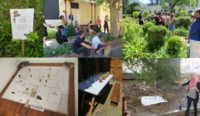Items
Site
The Medicine Chest
Is Part Of is exactly
Architecture, Planning & Geomatics
-

Where the Wild Things Are (Field study)
'Where the Wild Things Are' (21 October – 5 November 2014) explored the political, social and historical narratives embedded in the natural world through investigation, observation, mapping, archival research and art making. The exhibition consisted of various on-site interventions engaging with contemporary and historical spatial dynamics and the significance of Hiddingh Campus. The Egyptian Building (home to sculpture workshops and studios) was built on the site of a zoo established in the late eighteenth century that was replete with lion’s dens and a small lake that supposedly housed a hippo. The campus was also the home to UCT’s first Zoology and Botany building (now the Michaelis Building). This historical perspective highlights both the site’s colonial imprints and its early affiliation with the sciences. The UCT campus is divided into its main upper campus, a middle and lower campus, and a few satellite campuses, of which the Michaelis School of Fine Art and the South African College of Music form part. Students drew on the methodologies of artist/curator Mark Dion, collaborating with specialists from upper campus (entomologists, ornithologists and botanists) and Michaelis Fine Art students, to highlight its natural environment. The interventions occurred on different days, and over a two week period. A calendar was provided to stipulate event times and artwork appearances. Curated by Nina Liebenberg Participating artists: Christopher Swift, Dillon Marsh, Fritha Langerman, Thuli Gamedze, Pippa Skotnes, Alex Kaczmarek, Rone-Mari Botha, Jessica Holdengarde, Fanie Buys, Lara Reusch, Stephani Muller, Tegan Green, Evan Wigdorowitz, Mariam Moosa, C J Chandler, Adrienne Van Eeden-Wharton -

Door, 11 rue Larrey, New York.
-

Ma
The Japanese have a word, ‘ma’, for this interval which gives shape to the whole – this ‘gap’, ‘opening’, ‘space between’ or ‘time between’. Ma is not something that is created by compositional elements, rather it can be understood as the thing that takes place in the imagination of the human who experiences these elements. A room, for example, is called 'ma', as it refers to the space between the walls. Or a rest in music, which indicates a pause between the notes or sounds (Pilgrim 1986: 255). -

Where their lives took on true weight
In Alice Munro's short story 'Post and Beam', the two protagonists return home from a short vacation: "Up Capilano Road, into their own part of the city and their own corner of the world, where their lives took on true weight and their actions took on consequences. There were the uncompromising wooden walls of their house, showing through the trees" (Munro 2001: 212). -

House
Lokrete with metal armature Grove Road, London, E3 (Destroyed 11 January 1994) -

Intersections
"In recent years, particular interest has been directed at the resulting cross-pollinations and hybridities in the treatment of illness and disease that developed during the colonial and precolonial period from this heterogenous mix of cultures. Karen Flint’s 'Healing Traditions' (2008) and Digby’s 'Diversity and Division in Medicine' (2006) suggest that a complex structure of complementarity existed in which overlapping forms of health care had permeable and shifting boundaries (Digby 2006: 33; Flint 2008:7) illustrated perhaps most succinctly in the particularly porous field of botanical medicine, which almost all cultures utilised in their treatments to some extent" (Liebenberg 2021: x).


